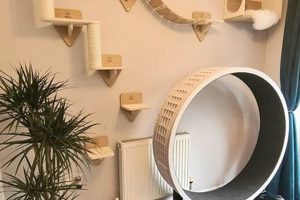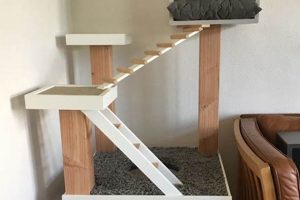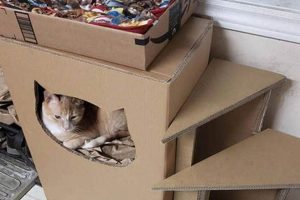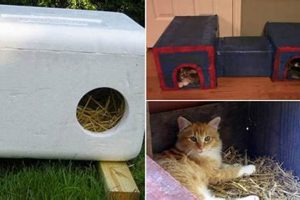The construction of shelters for unowned felines through do-it-yourself methods provides a tangible solution to protecting vulnerable animals from the elements. This undertaking involves utilizing readily available materials and basic construction techniques to create insulated structures capable of withstanding adverse weather conditions. For example, a simple shelter can be crafted from a plastic storage bin, lined with straw, and equipped with an entrance hole, offering refuge from rain, snow, and extreme temperatures.
Providing these shelters is crucial for the well-being of unowned cat populations, mitigating the risks associated with exposure and hypothermia, particularly during colder months. The practice has gained traction as a humane approach to community cat management, supplementing trap-neuter-release programs and promoting overall feline welfare. Historically, ad-hoc solutions using cardboard boxes or makeshift covers were common, evolving into more robust and insulated designs as awareness of the needs of these animals grew.
The following sections will delve into specific designs, material selection considerations, construction techniques, and strategies for placement and maintenance of these feline havens, maximizing their effectiveness in supporting the health and safety of unowned cats.
Construction and Placement Tips
The construction and placement of outdoor feline shelters require careful consideration to ensure maximum effectiveness and safety for the animals. Adherence to the following guidelines is essential for successful implementation.
Tip 1: Material Selection: Prioritize weather-resistant and insulating materials such as durable plastic bins, wood treated for outdoor use, or repurposed items like insulated coolers. Avoid absorbent materials like blankets or towels, which can retain moisture and promote bacterial growth.
Tip 2: Insulation is Key: Implement adequate insulation using straw (not hay), rigid foam insulation boards, or reflective bubble wrap. Ensure the insulation is securely contained to prevent cats from ingesting it.
Tip 3: Entrance Design: Create a small, offset entrance (approximately 6-8 inches in diameter) to minimize wind and rain entry. Consider a flap made of heavy canvas or rubber to further protect against the elements while allowing easy access.
Tip 4: Elevated Base: Position the structure on an elevated platform, such as bricks or wooden pallets, to prevent ground moisture from seeping into the shelter.
Tip 5: Placement Considerations: Select a sheltered location away from high-traffic areas, ideally near a building or fence for added protection. Ensure the shelter is placed on private property with permission or in designated community cat areas.
Tip 6: Multiple Exits: If feasible, provide two exits to allow cats to escape potential predators or territorial conflicts.
Tip 7: Camouflage and Concealment: Blend the shelter into its surroundings using natural materials or paint to minimize visibility and deter unwanted attention from humans or other animals.
By incorporating these tips into the creation and deployment process, the shelters can significantly improve the living conditions of free-roaming felines, offering a safe and comfortable refuge from harsh environmental conditions.
The concluding section will address long-term maintenance and strategies for encouraging cat usage of the newly constructed shelters.
1. Insulation Effectiveness
Insulation effectiveness is a primary determinant of the efficacy of shelters designed for unowned felines. Its role is to mitigate heat loss during cold weather and prevent excessive heat buildup during warm weather, thereby creating a thermally stable environment conducive to animal welfare.
- Material Thermal Resistance
Different materials possess varying degrees of thermal resistance (R-value). Materials such as straw, rigid foam boards, and reflective bubble wrap offer superior insulating properties compared to thin fabrics or bare plastic. The selection of high R-value materials directly influences the shelter’s ability to maintain a stable internal temperature, particularly during extreme weather conditions.
- Air Gap Incorporation
Air gaps between layers of insulating material can significantly enhance overall insulation effectiveness. These gaps disrupt convective heat transfer, further reducing heat loss or gain. Designs incorporating multiple layers with air gaps, such as double-walled structures with insulating fill, provide enhanced thermal performance.
- Shelter Size and Volume
The internal volume of the shelter impacts the rate at which it heats or cools. Smaller shelters are typically easier to heat with a cat’s body heat, but adequate ventilation remains crucial to prevent moisture buildup. Overly large shelters may require more significant insulating measures to maintain a comfortable temperature.
- Entrance Sealing
Even with effective insulation, heat loss can occur through the entrance. Implementing features such as small entrance sizes, offset entrances, or flexible flaps minimizes airflow and reduces heat transfer. Proper sealing of the entrance is critical for maximizing the benefits of the insulation efforts.
Collectively, these considerations underscore the importance of prioritizing insulation effectiveness when constructing shelters for unowned feline populations. By carefully selecting materials, incorporating air gaps, optimizing shelter size, and sealing entrances, shelters can provide a vital refuge from harsh weather conditions, significantly improving the animals’ chances of survival and well-being.
2. Entrance Size and Feline Shelter Design
The dimensions of the entrance to a do-it-yourself shelter for unowned felines are a critical design element, directly impacting the structure’s functionality and the safety of its occupants. Careful consideration must be given to entrance size to balance accessibility, protection from the elements, and security from predators.
- Thermal Regulation
A smaller entrance reduces heat loss during cold weather and minimizes the influx of warm air during hotter periods, contributing to thermal regulation within the shelter. Conversely, an excessively small entrance may deter larger cats or restrict access for those with mobility issues. Ideal dimensions typically range between 6 to 8 inches in diameter, offering a compromise between heat retention and accessibility. This range allows cats to enter and exit comfortably while limiting exposure to external temperature fluctuations.
- Predator Deterrence
The entrance size can act as a deterrent to larger predators, such as dogs or raccoons, which may attempt to enter the shelter. A smaller opening makes it more difficult for these animals to access the interior, providing a degree of security for the feline occupants. However, this must be balanced against the potential for trapping a cat inside if it feels threatened; therefore, providing a secondary exit is also advisable.
- Weather Protection
A reduced entrance size minimizes the entry of wind, rain, and snow into the shelter, maintaining a drier and more comfortable environment. Combined with an offset design or a protective flap, a smaller entrance can significantly improve the shelter’s weather resistance. Practical examples include shelters with partially covered entrances or flexible flaps made of heavy canvas or rubber, further mitigating weather intrusion.
- Cat Accessibility and Comfort
While security and weather protection are paramount, the entrance must be appropriately sized to allow cats of varying sizes to easily enter and exit. An excessively small entrance can discourage use, particularly by larger cats or those with physical limitations. Observation of community cats can inform appropriate size adjustments, ensuring the shelter remains accessible and appealing to the target population. Ultimately, the entrance must serve as an invitation, not a barrier, to safe refuge.
In conclusion, the entrance size is a multifaceted consideration in shelters. Balancing thermal regulation, predator deterrence, weather protection, and cat accessibility is critical to maximizing the effectiveness of shelters, offering a haven for vulnerable animals in diverse environmental conditions.
3. Weatherproofing
Weatherproofing constitutes a critical element in the design and construction of shelters for unowned felines. Exposure to inclement weather, including rain, snow, wind, and extreme temperatures, poses a significant threat to these animals’ survival and well-being. Failure to adequately weatherproof a structure renders it ineffective, potentially exacerbating the dangers of exposure. For instance, an unsealed wooden structure will absorb moisture, leading to rot, mold growth, and a damp, cold environment that offers little protection. Similarly, a shelter with an improperly sealed roof allows rainwater to penetrate, soaking the interior and negating the benefits of insulation.
Effective weatherproofing involves several key strategies: selection of water-resistant materials such as durable plastics or treated wood; proper sealing of seams and joints using caulk or weather stripping; and the incorporation of a waterproof roof with adequate overhang to divert rainwater away from the structure’s walls and entrance. Consider the example of a plastic storage bin shelter, where the lid must be securely attached and sealed to prevent water intrusion. The entrance should also be designed to minimize direct exposure to prevailing winds and precipitation. Implementing a small, offset entrance or adding a flexible flap can significantly reduce the amount of rain or snow entering the shelter.
Ultimately, thorough weatherproofing ensures the shelter remains a dry, insulated, and safe haven for unowned cats, protecting them from the potentially lethal effects of environmental exposure. Investing in durable, weather-resistant materials and meticulous construction techniques represents a practical and humane approach to supporting the health and survival of these vulnerable animals.
4. Predator protection
Predator protection constitutes a primary concern in the effective design and implementation of shelters for unowned feline populations. The vulnerability of these animals necessitates deliberate architectural considerations to mitigate potential threats from predators, thereby enhancing the safety and security of shelter occupants.
- Entrance Size and Placement
Restricting entrance dimensions serves as a fundamental defense mechanism, limiting access to larger predators such as dogs, coyotes, or raccoons. An entrance size between 6 and 8 inches typically allows feline entry while deterring larger animals. Furthermore, elevating the entrance slightly above ground level and orienting it away from prevailing winds can impede access and provide an added layer of security. Shelters positioned near walls or fences offer further protection by limiting predator approach vectors.
- Secondary Escape Exits
The incorporation of a secondary exit provides a crucial escape route for cats if a predator gains entry or if they feel threatened. This exit, typically smaller than the main entrance and located on an opposite side of the structure, allows felines to quickly evacuate the shelter without being cornered. The presence of an alternative escape path mitigates the risk of entrapment and significantly enhances the shelter’s protective capabilities.
- Durable Construction Materials
The structural integrity of the shelter is paramount in resisting predator attacks. Utilizing robust materials such as reinforced plastic, treated wood, or concrete blocks ensures the shelter can withstand attempts at forced entry. Securing all structural components with durable fasteners and reinforcing vulnerable areas further enhances the shelter’s resistance to damage from clawing, biting, or pushing by predators.
- Camouflage and Concealment
Concealing the shelter’s location through camouflage and strategic placement can reduce its visibility to potential predators. Blending the shelter into its surroundings by using natural materials or painting it in earth tones minimizes visual detection. Positioning the shelter in areas with dense vegetation or near natural barriers further obscures it from view, decreasing the likelihood of predator encounters. Shelters placed beneath decks, in sheds, or within fenced yards provide additional layers of concealment and security.
Integrating predator protection strategies into the design and construction of shelters for unowned felines constitutes a critical component of responsible animal welfare efforts. By implementing measures such as restricting entrance size, providing escape exits, utilizing durable construction materials, and employing camouflage techniques, the shelters can offer a safe and secure refuge for vulnerable animals, significantly improving their chances of survival in environments where predation represents a tangible threat.
5. Material Durability
The longevity and effectiveness of shelters constructed for unowned feline populations depend heavily on the durability of the selected materials. Material degradation, resulting from environmental exposure and physical stress, directly correlates with the shelter’s ability to provide consistent protection and refuge. For instance, utilizing untreated cardboard, while initially providing a temporary barrier, quickly deteriorates under conditions of rain or snow, rendering the shelter useless and potentially harmful. This lack of durability necessitates frequent replacement, increasing resource expenditure and disrupting the stability of the shelter environment for the animals.
The selection of durable materials represents a proactive approach to mitigating these issues. Options such as high-density polyethylene (HDPE) plastic, treated lumber, or repurposed insulated containers offer superior resistance to environmental factors. HDPE, for example, is waterproof, UV resistant, and impervious to many forms of physical damage, extending the shelter’s lifespan and reducing the need for constant maintenance. Similarly, pressure-treated lumber resists rot and insect infestation, ensuring structural integrity over extended periods. The implementation of such durable materials translates to a more sustainable and reliable shelter solution for unowned cats.
In summary, material durability is not merely a desirable attribute but a fundamental requirement for effective and humane shelter provision for unowned felines. The initial investment in durable materials yields long-term benefits by minimizing maintenance, maximizing shelter lifespan, and ensuring the continued well-being of the animals that rely on these structures. Prioritizing material durability is therefore essential for responsible and sustainable initiatives aimed at supporting these vulnerable populations.
6. Location Suitability
The selection of an appropriate location constitutes an integral aspect of shelters constructed for unowned felines. The location directly impacts shelter utilization, protection from environmental hazards, and security from potential threats. Inappropriate placement can render an otherwise well-designed shelter ineffective or even detrimental to the animals it is intended to protect.
- Protection from the Elements
An optimal location shields the shelter from direct exposure to harsh weather conditions, including strong winds, heavy rain, and intense sunlight. Placement under the eaves of a building, beneath a dense bush, or within a fenced enclosure provides natural barriers against these elements, thereby enhancing the shelter’s ability to maintain a stable and comfortable internal environment. Conversely, exposing the shelter to prevailing winds or direct sunlight can negate its insulating properties and deter feline usage.
- Minimizing Disturbance
Shelter placement should minimize human and animal disturbance. Selecting a location away from high-traffic areas, such as busy streets or playgrounds, reduces the likelihood of human interference or harassment. Similarly, positioning the shelter away from areas frequented by dogs or other territorial animals minimizes stress and the risk of conflict for the feline occupants. Quiet, secluded locations encourage consistent shelter use and promote a sense of security.
- Accessibility for Felines
While seclusion is important, the location must also be readily accessible to the target feline population. Positioning the shelter in a location that is easily reachable and does not require excessive climbing or maneuvering encourages use, particularly for older or less agile cats. Creating a clear pathway to the shelter and avoiding placement behind obstacles or in areas with dense vegetation improves accessibility and visibility.
- Compliance with Regulations and Property Rights
Prior to placement, ensuring compliance with local regulations and respecting property rights is crucial. Placement on private property requires explicit permission from the landowner. Adherence to any applicable ordinances regarding animal shelters or outdoor structures is also essential. Failure to comply with these regulations can result in removal of the shelter and potential legal consequences.
In conclusion, location suitability is a multifaceted consideration that significantly influences the efficacy of shelters constructed for unowned felines. Careful assessment of environmental factors, potential disturbances, accessibility, and legal compliance ensures that the shelter provides a safe, secure, and consistently utilized refuge for vulnerable animals.
7. Maintenance needs
The long-term utility of shelters constructed via do-it-yourself methods for unowned felines hinges on consistent maintenance. Neglecting maintenance protocols precipitates a decline in shelter condition, diminishing its protective capacity and potentially creating hazardous conditions for the animals.
- Cleaning and Sanitation
Regular removal of soiled bedding, debris, and accumulated waste is essential for preventing the proliferation of bacteria, parasites, and unpleasant odors. Failure to maintain a sanitary environment can lead to health issues among the feline occupants and deter shelter usage. Practical measures include replacing bedding weekly or bi-weekly, disinfecting the interior surfaces periodically, and removing any accumulated refuse from the surrounding area. A shelter contaminated with fleas, for example, will be avoided by cats and may become a source of infestation for other animals and the surrounding environment.
- Structural Integrity Checks
Periodic inspections of the shelter’s structural components are necessary to identify and address any signs of damage or deterioration. Cracks, leaks, or weakened joints compromise the shelter’s ability to provide adequate protection from the elements. Addressing these issues promptly, through repairs or reinforcement, prevents further damage and extends the shelter’s lifespan. A leaking roof, for instance, will saturate the insulation, negating its thermal properties and creating a damp, uncomfortable environment.
- Pest Control Measures
Shelters can attract unwanted pests such as insects, rodents, or other animals seeking food or shelter. Implementing preventative measures, such as sealing potential entry points and eliminating food sources, minimizes the risk of infestation. In the event of an infestation, appropriate pest control measures should be implemented, ensuring the safety of the feline occupants. Rodent droppings within the shelter, for example, pose a health risk and can deter cats from using the structure.
- Seasonal Adjustments
Adapting the shelter to seasonal changes is crucial for maintaining its effectiveness year-round. During winter months, ensuring adequate insulation and sealing drafts minimizes heat loss. In summer, providing ventilation and shade prevents overheating. Adjusting the shelter’s configuration based on seasonal needs optimizes its comfort and utility for the feline occupants. For instance, adding a layer of straw for insulation during winter and removing it during summer helps maintain a comfortable temperature.
Consistent and attentive maintenance directly correlates with the long-term effectiveness of these shelters, ensuring they continue to provide a safe, sanitary, and comfortable refuge for unowned felines throughout the year. Neglecting these maintenance protocols undermines the initial investment of time and resources and compromises the well-being of the animals the shelters are intended to protect.
Frequently Asked Questions
This section addresses common inquiries regarding the construction and maintenance of shelters for unowned cats, offering clarity and guidance for individuals engaged in these efforts.
Question 1: What constitutes suitable insulation material for a shelter?
Acceptable insulation materials include straw (not hay), rigid foam insulation boards, and reflective bubble wrap. Materials like blankets or towels are discouraged due to their moisture-retentive properties, which can lead to bacterial growth and reduced insulation effectiveness.
Question 2: How frequently should shelters be cleaned?
Shelters should undergo cleaning at least bi-weekly, or more frequently as needed, to remove soiled bedding, debris, and accumulated waste. Regular sanitation minimizes the risk of disease transmission and ensures a hygienic environment for the cats.
Question 3: What is the optimal size for a shelter entrance?
An entrance measuring approximately 6 to 8 inches in diameter strikes a balance between accessibility for cats and protection from the elements and potential predators. This size restriction limits heat loss while permitting easy entry and exit.
Question 4: How can the risk of attracting unwanted pests be minimized?
Implementing preventative measures such as sealing potential entry points, eliminating food sources, and regularly cleaning the shelter significantly reduces the likelihood of pest infestations. Addressing any existing infestations promptly is crucial to maintaining a sanitary environment.
Question 5: Where should shelters be positioned to maximize their effectiveness?
Optimal placement involves selecting a sheltered location away from high-traffic areas, ideally near a building or fence for added protection. Ensuring the location is accessible to cats and compliant with local regulations is also essential.
Question 6: How can shelter construction costs be minimized?
Repurposing readily available materials, such as plastic storage bins, insulated coolers, or scrap lumber, provides a cost-effective alternative to purchasing new materials. These repurposed items can be modified to create functional and durable shelters at minimal expense.
Consistent attention to these considerations contributes significantly to the success of shelter programs, ensuring that these structures provide a safe and supportive environment for unowned feline populations.
The subsequent section will present examples of shelter designs, illustrating practical applications of the principles discussed herein.
Conclusion
The preceding discussion has illuminated various aspects of the construction and maintenance of shelters for unowned felines. From material selection and insulation techniques to entrance design and location suitability, each element contributes significantly to the effectiveness of these structures in protecting vulnerable animals. Adherence to these guidelines increases the likelihood of shelter utilization and enhances the overall well-being of the target population. The practice of stray cat house diy presents a tangible means of positively impacting the lives of these animals. This has been proven through research, results and by statistics.
The provision of adequate shelters represents a responsible and humane approach to community cat management. Continued effort in this area, coupled with broader initiatives such as trap-neuter-release programs, holds the potential to improve the lives of countless unowned felines, fostering more compassionate and sustainable communities.







